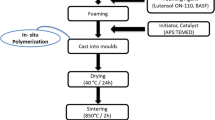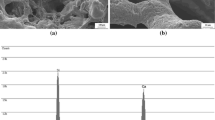Abstract
Zirconia toughened alumina (ZTA) has been regarded as the next generation orthopedic graft material due to its excellent mechanical properties and biocompatibility. Porous ZTA ceramics with good interconnectivity can potentially be used as bone grafts for load-bearing applications. In this work, three-dimensional (3D) interconnected porous ZTA ceramics were fabricated using a direct foaming method with egg white protein as binder and foaming agent. The results showed that the porous ZTA ceramics possessed a bimodal pore size distribution. Their mechanical properties were comparable to those of cancellous bone. Due to the bio-inertness of alumina and zirconia ceramics, surface bioactivation of the ZTA foams was carried out in order to improve their bioactivity. A simple NaOH soaking method was employed to change the surface chemistry of ZTA through hydroxylation. Treated samples were tested by conducting osteoblast-like cell culture in vitro. Improvement on cells response was observed and the strength of porous ZTA has not been deteriorated after the NaOH treatment. The porous ‘bioactivated’ ZTA ceramics produced here could be potentially used as non-degradable bone grafts for load-bearing applications.








Similar content being viewed by others
References
L.L. Hench, Bioceramics. J. Am. Ceram. Soc. 81(7), 1705–1728 (1998)
E. Fidancevska, G. Ruseska, J. Bossert, Y. Lin, A.R. Boccaccini, Fabrication and characterization of porous bioceramic composites based on hydroxyapatite and titania. Mater. Chem. Phys. 103, 95–100 (2007)
X. Miao, Y. Hu, J. Liu, X. Huang, Hydroxyapatite coating on porous zirconia. Mater. Sci. Eng. C 27, 257–261 (2007)
G. Willmann, Ceramic femoral head for total hip arthroplasty. Adv. Eng. Mater. 2(3), 114–121 (2000)
S. Bose, J. Darsell, M. Kintner, H. Hosick, A. Bandyopadhyay, Pore size and pore volume effects on alumina and TCP ceramic scaffolds. Mater. Sci. Eng. C 23, 479–486 (2003)
J. Pierri, E.B. Roslindo, R. Tomasi, E. Pallone, E. Rigo, Alumina/zirconia composite coated by biomimetic method. J. Non-Cryst. Solids 352, 5279–5283 (2006)
F.F. Lange, K.T. Miller, Open cell, low-density ceramics fabricated from reticulated polymer substrates. Adv. Ceram. Mater. 2(4), 827 (1987)
C. Tuck, J.R.G. Evans, Porous ceramics prepared from protein foams. J.Mater. Sci. Lett. 18, 1003 (1999)
S. Dhara, P. Bhargava, Simple direct casting route to ceramic foams. J. Am. Ceram. Soc. 86(10), 1645–1650 (2003)
A.O. Engin, A.C. Tas, Manufacture of macroporous calcium hydroxyapatite bioceramics. J. Eur. Ceram. Soc. 19, 2569 (1999)
S.J. Yarram, C. Tasman, J. Gidley, M.J.R. Clare Sandy, J.P. Mansell, Epidermal growth factor and calcitriol synergistically induce osteoblast maturation. Mol Cell Endocrinol. 220, 9–20 (2004)
S. Deville, J. Chevalier, G. Fantozzi et al., Low-temperature ageing of zirconia-toughened alumina ceramics and its implication in biomedical implants. J. Eur. Ceram. Soc. 23, 2975–2982 (2003)
A.R. Studart, U.T. Gonzenbach, E. Tervoort et al., Processing routes to macroporous ceramics: a review. J. Am. Ceram. Soc. 89(6), 1771–1789 (2006)
H.X. Peng, Z. Fan, J.R.G. Evans et al., Microstructure of ceramic foams. J. Eur. Ceram. Soc. 20, 807–813 (2000)
K.A. Hing, Bioceramic bone graft substitutes: influence of porosity and chemistry. Int. J. Appl. Ceram. Technol. 2(3), 184–199 (2005)
H.F. Hildebrand, N. Blanchemain, G. Mayer, F. Chai, M. Lefebvre, F. Boschin, Surface coatings for biological activation and functionalization of medical devices. Surf. Coat. Technol. 200, 6318 (2006)
K. Yamashita, E. Yonehara, X.F. Ding, M. Nagai, T. Umegaki, M. Matsuda, Electrophoretic coating of multilayered apatite composite on alumina ceramics. J. Biomed. Mater. Res. 43(1), 46–53 (1998)
C.F. Koch, S. Johnson, D. Kumar, M. Jelinek, D.B. Chrisey, A. Doraiswamy, C. Jin, R.J. Narayan, I.N. Mihailescu, Pulsed laser deposition of hydroxyapatite thin films. Mater. Sci. Eng. C 27, 484–494 (2007)
K. Rezwana, Q.Z. Chena, J.J. Blakera, A.R. Boccaccini, Biodegradable and bioactive porous polymer/inorganic composite scaffolds for bone tissue engineering. Biomaterials 27, 3413 (2006)
H. Fischer, C. Niedhart, N. Kaltenborn, A. Prange, R. Marx, F.U. Niethard, R. Telle, Bioactivation of inert alumina ceramics by hydroxylation. Biomaterials 26, 6151–6157 (2005)
T. Shirai, C. Ishizaki, K. Ishizaki, Effects of Manufacturing Processes on Hydration Ability of High Purity (-Al2O3 Powders. J. Jpn. Ceram. Soc. 114, 286–289 (2006)
B. Su, X. He, S. Dhara, J.P. Mansell, Porous and Bioactive Alumina Ceramics for Bone Grafts and Tissue Engineering Scaffolds. Key Eng. Mater. 330–332, 975–978 (2007)
L.L. Hench, J. Wilson, An Introduction to Bioceramics (World Scientific, London, U.K., 1993)
P. Colombo, J.R. Hellmann, D.L. Shelleman, Mechanical properties of silicon oxycarbide ceramic foams. J. Am. Ceram. Soc. 84(10), 2245 (2001)
K. Anselme, Osteoblast adhesion on biomaterials. Biomaterials 21, 667 (2000)
Acknowledgements
Dr. RP Shellis was thanked for his help to use FTIR instrument and useful discussions. Dr. S Dhara was thanked for initial discussion.
Author information
Authors and Affiliations
Corresponding author
Rights and permissions
About this article
Cite this article
He, X., Zhang, Y.Z., Mansell, J.P. et al. Zirconia toughened alumina ceramic foams for potential bone graft applications: fabrication, bioactivation, and cellular responses. J Mater Sci: Mater Med 19, 2743–2749 (2008). https://doi.org/10.1007/s10856-008-3401-x
Received:
Accepted:
Published:
Issue Date:
DOI: https://doi.org/10.1007/s10856-008-3401-x




